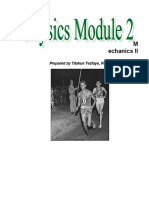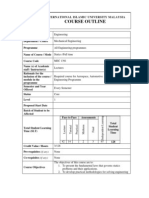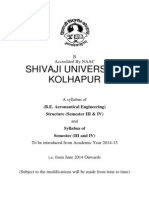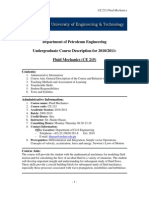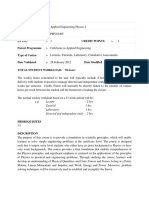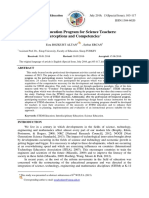Course Specifications: A-Basic Information
Course Specifications: A-Basic Information
Uploaded by
Ahmed KhairyCopyright:
Available Formats
Course Specifications: A-Basic Information
Course Specifications: A-Basic Information
Uploaded by
Ahmed KhairyOriginal Title
Copyright
Available Formats
Share this document
Did you find this document useful?
Is this content inappropriate?
Copyright:
Available Formats
Course Specifications: A-Basic Information
Course Specifications: A-Basic Information
Uploaded by
Ahmed KhairyCopyright:
Available Formats
University: Cairo
Faculty: Engineering
Department: Aerospace Engineering
Course Specifications
Programme on which the course is given: Aerospace Engineering Major or Minor element of programmes: Major Department offering the programme : Aerospace Engineering Department Department offering the course : Engineering Mathematics and Physics Department Academic year/level : First year Date of specification approval : November, 2007.
A- Basic Information
Title : Mechanics II Code : MEC116 Specification is not based on credit hour system. However, equivalent is computed based on: credit hour = contact hour for lecture, credit hour = 2 contact hours for tutorial or practical: Lecture: 4 Tutorial: 1 Practical: 0 (contact hours per week: Lecture 4, Tutorial 2, Total 6 hours)
Total: 5
B- Professional information
1- Overall Aims of Course
Plane Motion This part of the course aims at enabling the student to master the different aspects of the plane motion of systems of rigid bodies and to construct sound mathematical models thereof; adopting the Newton-Euler approach. Space Motion This part of the course aims at giving the student a complete idea of the space motion of particles and rigid bodies, and to enable him to increase his own information about this subject.
2- Intended Learning Outcomes of Course (ILOs)
At the end of this course, the student should be able to: a- Knowledge and understanding: Plane Motion a1- comprehend the notions of rigid body and plane motion. a2- define angular velocity and angular acceleration. a3- derive and apply velocity and acceleration relations for two points of a body. a4- memorize, identify, and express types of constraints. a5- memorize, identify, and handle special types of motion. a6- recognize and express the suitable number of initial conditions. a7- identify, classify, and express forces and couples. a8- memorize and apply Newton-Euler laws of motion. a9- memorize expressions for linear and angular momentum and kinetic energy. a10- memorize and apply laws of impulsive motion and energy conservation.
Aerospace Engineering
1/4
MEC116 Mechanics II.doc
Space Motion a11- define Eulers angles and to use them to express orientation. a12- define and express the angular velocity vector. a13- differentiate vectors expressed in terms of rotating axes. a14- express velocity and acceleration of a point. a15- analyze the kinematics of particles, bodies, and mechanisms. a16- determine principal moments and principal axes of inertia. a17- define and express angular momentum vector and kinetic energy. a18- identify special types of motion of rigid bodies. a19- derive and use Eulers equations. a20- get acquainted with Lagranges equations of motion. b- Intellectual Skills: Plane Motion b1- deal with mechanical systems in a systematic way. b2- analyze mechanical systems, descriptively. b3- make assumptions and check their correctness. Space Motion b4- decide which system(s) of axes (fixed or rotating) to use. b5- confidently utilize and manipulate vectors. b6- employ suitable dynamical equations. c- Professional and Practical Skills: c1- construct sound mathematical models for mechanical systems. c2- practice problem solving. c3- master the kinematical analysis of space mechanisms. c4- apply different approaches to space dynamics. d- General and Transferable Skills: d1- to work in a group. d2- to prepare technical reports. d3- to give presentations. d4- to follow a systematic approach in all fields of interest.
3- Contents
Topic No. of hours 2 6 6 4 6 6 8 38 2 4 8 2 Lecture 2 4 4 2 4 4 6 26 2 2 4 2 Tutorial/ Practical 2 2 2 2 2 2 12 2 4
Introduction: rigid body- system- plane motion Angular velocity- Velocity and acceleration relationsMotion relative to a body- Coriolis Acceleration Constrained motion- Constraint equations Force analysis Equations of motion Work/energy relation- Conservation of energy Impulsive motion Plane motion: total Introduction to space motion of particles and rigid bodies Motion of a particle relative to fixed axes Motion of a particle relative to moving axes Rotation of a rigid body- Eulers angles Aerospace Engineering
2/4
MEC116 Mechanics II.doc
Angular velocity and acceleration vectors for a rigid body Special rigid body rotations: gyroscopic, rolling, Space kinetics of rigid bodies- Inertia tensor Principal axes and principal moments of inertia Angular momentum vector- kinetic energy Motion equations: Eulers equations- Lagranges equations Space motion: total Total
4 6 2 4 2 6 40 78
2 4 2 2 2 4 26 52
2 2 2 2 14 26
4- Teaching and Learning Methods
4.1- Stand-up lectures. 4.2- Problem-solving sessions. 4.3- One-to-one discussions.
5- Student Assessment Methods
5.1- Assignments to assess mastery of specific subjects. 5.2- Mid-Term Examination to assess mastery of subjects taught till mid-term. 5.3- Group Assignment to assess mastery of mathematical modeling of plane motion. 5.4- Final-Term Examination to assess overall achievement. Assessment schedule Assessment 1: Weeks: 2-12 (Semester Work) Assessment 2: Weeks: 4-12 (Group Assignment) Assessment 3: Week: 8 (Mid-Term Examination) Assessment 4: Week: 15 (Final Examination) Weighting of assessments Mid-Term Examination 16% Final-term Examination 66% Oral Examination. 0% Practical Examination 0% Semester Work 13% Other types of assessment 3% (group assignment) ---------------------------------------------------Total 100% Any formative only assessments
6- List of References
6.1- Course notes: Hand-outs (Theoretical aspects + solved examples). 6.2- Essential books (text books): Not available. 6.3- Recommended books Principles of Engineering Mechanics, H.R. Harrison & T. Nettleton, ELBS, 1979. Engineering Mechanics, J.L. Meriam, Vol. 2, 1987. Vector Mechanics for Engineers (Dynamics), F.P. Beer & E.R. Johnston, 1977. 6.4- Periodicals, Web sites, etc.: Not applicable.
7- Facilities Required for Teaching and Learning 7.1- Computer + suitable software: to prepare lectures, handouts, 7.2- Presentation facilities: data show unit, screen, pointers, 7.3- Internet connection: to facilitate lecturer/student communications.
3/4
Aerospace Engineering
MEC116 Mechanics II.doc
7.4- Microphone: Lecture room is in a noisy location. 7.5- Text book Course coordinator: Tarek M. A. El-Mistikawy Head of Department: Professor M. Samir Tosson Abdel-Wahed Date: November, 2007.
Aerospace Engineering
4/4
MEC116 Mechanics II.doc
You might also like
- Qa Learning Plan FormDocument3 pagesQa Learning Plan Formapi-283556453100% (1)
- MEng BristolDocument47 pagesMEng BristolvklsNo ratings yet
- Orientation and Identity in Community ArchitectureDocument26 pagesOrientation and Identity in Community ArchitectureDarren Vergara75% (4)
- Parallel Class ResearchG3Document6 pagesParallel Class ResearchG3Manilyn Samson Fernandez0% (1)
- Course Outline: International Islamic University MalaysiaDocument6 pagesCourse Outline: International Islamic University Malaysiade_stanszaNo ratings yet
- Mechanics IIDocument88 pagesMechanics IIHema AnilkumarNo ratings yet
- Aerospace Engineering AER307B Mechanics of Flight and Control - Doc 1/3Document3 pagesAerospace Engineering AER307B Mechanics of Flight and Control - Doc 1/3scribNo ratings yet
- Course Outline: International Islamic University MalaysiaDocument5 pagesCourse Outline: International Islamic University MalaysiafazdrulakiffNo ratings yet
- Physics B Syllabus 4Document7 pagesPhysics B Syllabus 4sbl274No ratings yet
- Engineering Mechanics Course Out ComesDocument5 pagesEngineering Mechanics Course Out ComesallakagopichandNo ratings yet
- HTTPS://WWW - Scribd.com/document/388186005/concise Inorganic Chemistry 5th Edition PDFDocument1 pageHTTPS://WWW - Scribd.com/document/388186005/concise Inorganic Chemistry 5th Edition PDFAryan SinghNo ratings yet
- Jawaharlal Nehru Technological University: Kakinada KAKINADA - 533 003, Andhra Pradesh, IndiaDocument3 pagesJawaharlal Nehru Technological University: Kakinada KAKINADA - 533 003, Andhra Pradesh, IndiaPrakash Kumar SenNo ratings yet
- 9028Document127 pages9028BHOOMINo ratings yet
- Link FileDocument54 pagesLink Filesakshi17248dubeyNo ratings yet
- 4 Hours/ Week X 12 Weeks 48 Hours: 2 Hrs. Tutorial 1 Hr. Laboratory 1 Hr. Directed and Independent Study 4hrsDocument6 pages4 Hours/ Week X 12 Weeks 48 Hours: 2 Hrs. Tutorial 1 Hr. Laboratory 1 Hr. Directed and Independent Study 4hrsAllana HNo ratings yet
- Mechanical Engineering Dynamics: (Higher)Document53 pagesMechanical Engineering Dynamics: (Higher)Anonymous FGryb4rEgNNo ratings yet
- Aeronautical Syllabus-Shivaji University - R.H.B. RamamurthyDocument36 pagesAeronautical Syllabus-Shivaji University - R.H.B. RamamurthyZachary GuerraNo ratings yet
- Course Specifications: Cairo EngineeringDocument3 pagesCourse Specifications: Cairo EngineeringscribNo ratings yet
- Course Description (Ce 215)Document4 pagesCourse Description (Ce 215)Yasir IrfanNo ratings yet
- PHYS1005 - Applied Engineering Physics IDocument6 pagesPHYS1005 - Applied Engineering Physics IChristiana SukhuNo ratings yet
- Phy 301Document136 pagesPhy 301Pelumi AjiboyeNo ratings yet
- Acad - Yr. 2013-14,2014-15 &: M.V.S.R. Engineering College, Nadergul Hyderabad - 501 510 Department of Civil EngineeringDocument2 pagesAcad - Yr. 2013-14,2014-15 &: M.V.S.R. Engineering College, Nadergul Hyderabad - 501 510 Department of Civil EngineeringNaresh KumarNo ratings yet
- Common Pool of Generic Electives (Ge) Courses: Category-IVDocument3 pagesCommon Pool of Generic Electives (Ge) Courses: Category-IVvalacfosaleNo ratings yet
- TE Syllabus Mech PDFDocument40 pagesTE Syllabus Mech PDFSanket JadhavNo ratings yet
- AP Physics C - Mech - Syllabus - Dev - Guide - 2024Document13 pagesAP Physics C - Mech - Syllabus - Dev - Guide - 2024gulsah erenNo ratings yet
- Phy 301 Classical MechanicsDocument100 pagesPhy 301 Classical MechanicsGabriel EgrinyaNo ratings yet
- Holy Spirit University of Kaslik: Course SyllabusDocument4 pagesHoly Spirit University of Kaslik: Course SyllabusElie OtayekNo ratings yet
- Topic 1.4: Projectile MotionDocument10 pagesTopic 1.4: Projectile MotionromwamaNo ratings yet
- ME6401 Kinematics of Machinery: Objective Oriented Learning Process Format RBT (OLF)Document6 pagesME6401 Kinematics of Machinery: Objective Oriented Learning Process Format RBT (OLF)Prasath MurugesanNo ratings yet
- Physics Syllabus - Grade 12 and 13 - Sri LankaDocument48 pagesPhysics Syllabus - Grade 12 and 13 - Sri LankaThisura Seniya Ratnayake0% (1)
- MENG1003 Course Descriptor (1) - 54645703Document7 pagesMENG1003 Course Descriptor (1) - 54645703Gregory CameraNo ratings yet
- Courses Description 50Document3 pagesCourses Description 50scribNo ratings yet
- Syllabus MEC262 Summer2019Document12 pagesSyllabus MEC262 Summer2019abuinskiNo ratings yet
- PHY307 Solid StateDocument213 pagesPHY307 Solid StateFaderera AikoyeNo ratings yet
- N201 CF121 Physics IDocument2 pagesN201 CF121 Physics IJuan EspejoNo ratings yet
- ENGR 3122 - Dynamics - Syllabus Veazie Fall 2016Document7 pagesENGR 3122 - Dynamics - Syllabus Veazie Fall 2016manoman12345No ratings yet
- Syllabus ApDocument5 pagesSyllabus Apapi-200743981No ratings yet
- CEME 1004 - Engineering Mechanics - Statics - Course OutlinesDocument5 pagesCEME 1004 - Engineering Mechanics - Statics - Course OutlinesahmedajelNo ratings yet
- JSDO1asd 3n AsdDocument2 pagesJSDO1asd 3n AsdAnonimus290599No ratings yet
- Goods and Services Mech 101 Course Outline 2020Document8 pagesGoods and Services Mech 101 Course Outline 2020Teddy MukadzamboNo ratings yet
- Engineering ThermodynamicsDocument74 pagesEngineering Thermodynamicsm_mukbel8752No ratings yet
- Course Outline: Meng6302 Advanced Mechanics of SolidsDocument7 pagesCourse Outline: Meng6302 Advanced Mechanics of SolidsKKDhNo ratings yet
- Mech 101 Course Outline 2022Document8 pagesMech 101 Course Outline 2022teddiengadzeNo ratings yet
- Me 170-SylDocument2 pagesMe 170-Sylememem5No ratings yet
- Syllabus_MEC262_Summer2022(2)Document12 pagesSyllabus_MEC262_Summer2022(2)Omar AlasNo ratings yet
- Course Specifications: A-Basic InformationDocument3 pagesCourse Specifications: A-Basic Informationanon_640786597No ratings yet
- Kom CoursefileDocument53 pagesKom CoursefileManda Ramesh BabuNo ratings yet
- PH1016 SylabusDocument5 pagesPH1016 Sylabusphamtungduong0308No ratings yet
- Major Programme Compulsory) enDocument11 pagesMajor Programme Compulsory) ensilensaNo ratings yet
- Rancangan THN Fizik f4 2013Document23 pagesRancangan THN Fizik f4 2013qq235No ratings yet
- 960 SP Physics 2012Document135 pages960 SP Physics 2012Mohd SharulniZamNo ratings yet
- Phy 107Document2 pagesPhy 107fahadNo ratings yet
- Mece 204 e - 2012Document3 pagesMece 204 e - 2012Levent özerNo ratings yet
- MECE2304 SylDocument6 pagesMECE2304 Syltiger94731897No ratings yet
- IME Dynamics EIM 211 Course OutlineDocument4 pagesIME Dynamics EIM 211 Course OutlineAnonymous XybLZfNo ratings yet
- Fundamentals of Physics Course OutlineDocument4 pagesFundamentals of Physics Course OutlinesolomonrolanaNo ratings yet
- Full SyllabusDocument116 pagesFull Syllabusmahtabali100% (1)
- Scheme of Work - FM 4 PhysicsDocument29 pagesScheme of Work - FM 4 PhysicsNor Rasyidah Anis AzmiNo ratings yet
- MA501-N Theory of MachineDocument3 pagesMA501-N Theory of Machinehrana287No ratings yet
- AP Physics 1 Premium, 2025: Prep Book with 4 Practice Tests + Comprehensive Review + Online PracticeFrom EverandAP Physics 1 Premium, 2025: Prep Book with 4 Practice Tests + Comprehensive Review + Online PracticeNo ratings yet
- Complex Variables for Scientists and Engineers: Second EditionFrom EverandComplex Variables for Scientists and Engineers: Second EditionRating: 5 out of 5 stars5/5 (1)
- Learning Skill: Dr. Jayalangkara Tanra SP - KJDocument21 pagesLearning Skill: Dr. Jayalangkara Tanra SP - KJFaris AzharNo ratings yet
- Gade Final Internship ReportDocument46 pagesGade Final Internship Reportapi-300163172No ratings yet
- Monday Tuesday Wednesday Thursday Friday: GRADES 1 To 12 Daily Lesson LogDocument4 pagesMonday Tuesday Wednesday Thursday Friday: GRADES 1 To 12 Daily Lesson LogLorimae VallejosNo ratings yet
- Holdman - Classroom Management Implementation PlanDocument4 pagesHoldman - Classroom Management Implementation Planapi-210118947No ratings yet
- Rosemont Math HomeworkDocument8 pagesRosemont Math Homeworkjwtwqtsif100% (1)
- Amelia Hasbrouck ResumeDocument3 pagesAmelia Hasbrouck Resumeapi-238297343No ratings yet
- The Oppidan Press. Edition 3. 2013Document16 pagesThe Oppidan Press. Edition 3. 2013The Oppidan PressNo ratings yet
- Curriculum Deve-WPS OfficeDocument9 pagesCurriculum Deve-WPS OfficeLovely Venia JovenNo ratings yet
- Detailed Lesson Plan in English 3Document3 pagesDetailed Lesson Plan in English 3サシンゴ ラアーニ100% (1)
- Gafcs Apr 2020 NewsletterDocument5 pagesGafcs Apr 2020 Newsletterapi-243234232No ratings yet
- 1 Nishant Jindal Dominate JEE The Gospel of JEE Nishant Jindal PDF PDFDocument71 pages1 Nishant Jindal Dominate JEE The Gospel of JEE Nishant Jindal PDF PDFLearn Tech100% (2)
- Junior High School Mathematics Contest Exam 2005Document9 pagesJunior High School Mathematics Contest Exam 2005Weerasak BoonwuttiwongNo ratings yet
- What If?Document119 pagesWhat If?workout50No ratings yet
- Team 4 - 4c-Id 5p Rubric - FinalDocument6 pagesTeam 4 - 4c-Id 5p Rubric - Finalapi-369902105No ratings yet
- SAT Practice Test 5 PDFDocument144 pagesSAT Practice Test 5 PDFSohaylla MusadNo ratings yet
- STEM Education Program For Science TeachDocument15 pagesSTEM Education Program For Science TeachThuy TangNo ratings yet
- Language Arts Lesson Plan CharacterizationDocument2 pagesLanguage Arts Lesson Plan Characterizationapi-242651169No ratings yet
- "Disrupting Class: How Disruptive Innovation Will Change The Way The World Learns" by Clayton M. Christensen, Curtis W. Johnson, and Michael B. HornDocument3 pages"Disrupting Class: How Disruptive Innovation Will Change The Way The World Learns" by Clayton M. Christensen, Curtis W. Johnson, and Michael B. HornSamuel Luis MendozaNo ratings yet
- 1 Set - DefinitionDocument2 pages1 Set - DefinitionDawn RazonableNo ratings yet
- Engineering Fresher Resume Sample DownloadDocument2 pagesEngineering Fresher Resume Sample DownloadPrabhat Kumar ShrivastavaNo ratings yet
- Sample Statement of PurposeDocument8 pagesSample Statement of PurposeMichael AsieduNo ratings yet
- Advertising & Promotion: BBSSM1202Document16 pagesAdvertising & Promotion: BBSSM1202akmohideenNo ratings yet
- GD Topics of Past Year: GD Topic: Should Business Lobbying Be Made Legal in India?Document4 pagesGD Topics of Past Year: GD Topic: Should Business Lobbying Be Made Legal in India?Abhishek GhatakNo ratings yet
- Learn Words About A New SubjectDocument20 pagesLearn Words About A New Subjectsuchi ravaliaNo ratings yet
- Almanac 2024 2025 SharedDocument4 pagesAlmanac 2024 2025 Sharedpatrokilikimaro574No ratings yet
- Ela Eld Lesson PlanDocument6 pagesEla Eld Lesson Planapi-332723336No ratings yet
- Penyerahan Dan Penilaian Tugasan: Assignment Submission and AssessmentDocument9 pagesPenyerahan Dan Penilaian Tugasan: Assignment Submission and AssessmentaziezudinNo ratings yet





